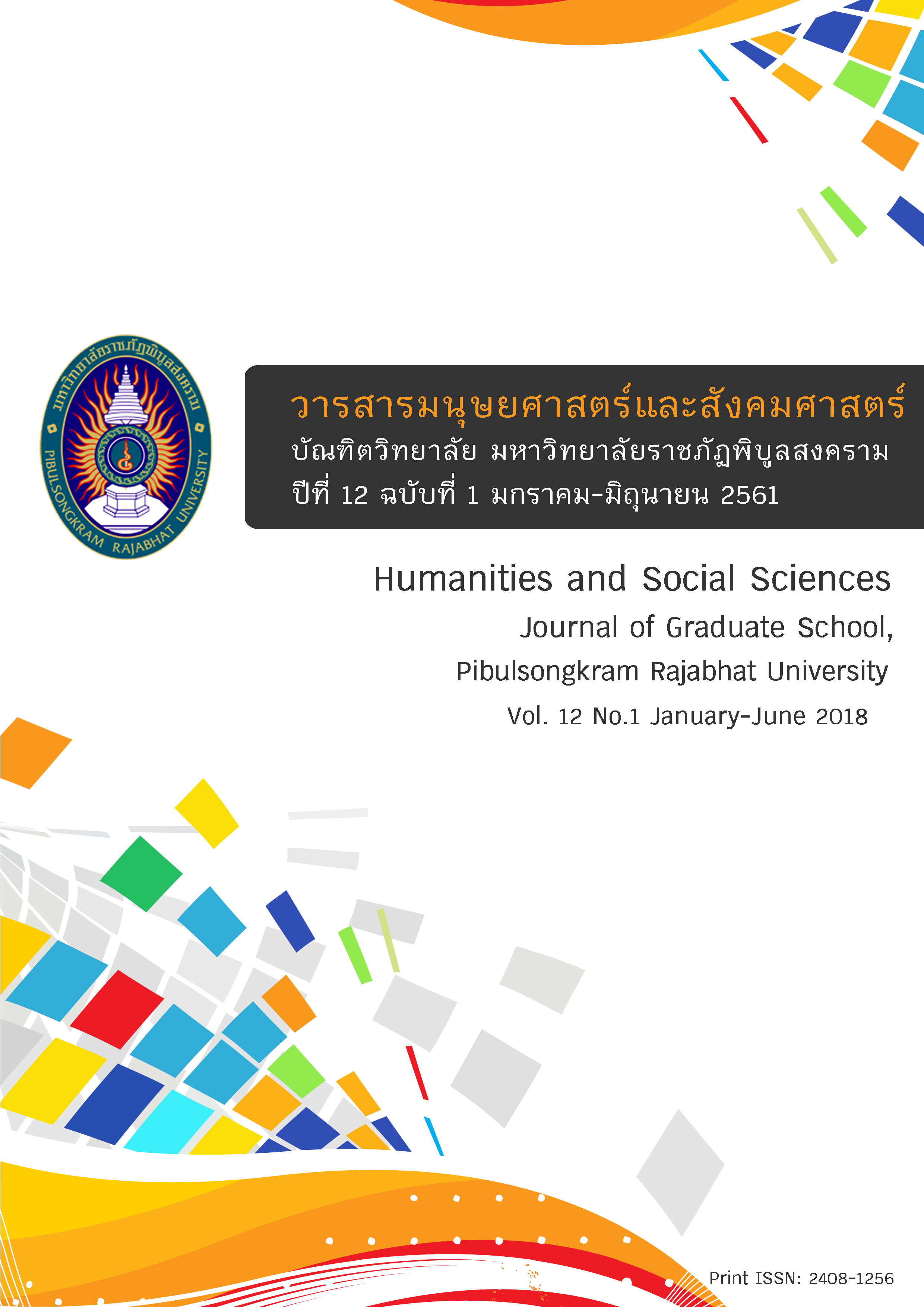The Development of Learning Model for Enhancing Critical Thinking Ability in Mathematics of Junior High School Students
Keywords:
Learning model, Critical thinking, MathematicsAbstract
This research study attempted (1) to study good practices in learning management for enhancing critical thinking ability in mathematics and (2) to develop a learning management model for enhancing critical thinking ability in mathematics of junior high school students. The population was mathematics teachers teaching in the junior high school level at 12 schools which are in Princess Chulabhorn’s college Group. After the cluster random sampling, the samples were 55 mathematics teachers working at 8 schools in the stated group and consenting to provide the researcher information. The research instrument was a 4 item- open-ended questionnaire with content validity index (I-CVI) ranged from 0.80 to 1.00. The development of research methodology was conducted through two phases: conducting documentary research and field research (Phase 1: R), developing the prototype of the instructional model for enhancing the junior high school students’ critical thinking ability (Phase 2: D). The statistical treatment for data analysis was frequency, percentage and content analysis which revealed the findings below:
(1) According to the teacher's opinion of a good practice in mathematics learning management, it consists of (1.1) linking prior knowledge with new knowledge, (1.2) applying new knowledge (group processes) and presentations, (1.3) using real life /problems world/ PISA international exams, (1.4) demonstrating a new knowledge to students and (1.5) integration of new knowledge into the students’ real life experience.
(2) A learning management model for enhancing critical thinking ability in mathematics of junior high school students consists of four elements: Integration (practice by using real world problems), activation (by using game, questioning, video, quiz), demonstration (through teacher’s awareness of knowledge, presentation of solutions and examples useful to students) and application/ implementation (through doing exercises, taking national and international standards test, and learning by doing through a project work).
References
ชั้นมัธยมศึกษาปีที่ 3 โดยใช้กิจกรรมการเรียนการสอนตามรูปแบบแวน ฮีลี. (วิทยานิพนธ์ศึกษาศาสตรมหาบัณฑิต). มหาวิทยาลัยเชียงใหม่, เชียงใหม่.
กฤษณาพร สายรอด. (2554). การใช้ปัญหาปลายเปิดทางคณิตศาสตร์เพื่อส่งเสริมการคิดอย่างมีวิจารณญาณของนักเรียนชั้นมัธยมศึกษาปีที่ 2 โรงเรียนบ้านใหม่ศรีนครจังหวัดนครสวรรค์. (วิทยานิพนธ์ศึกษาศาสตรมหาบัณฑิต). มหาวิทยาลัยเชียงใหม่, เชียงใหม่.
โครงการ PISA ประเทศไทย. (2554). ปัจจัยที่ทำให้ระบบโรงเรียนประสบความสำเร็จ ข้อมูลพื้นฐานจากโครงการประเมินผลนักเรียนนานาชาติ PISA 2009. กรุงเทพฯ: สถาบันส่งเสริมการสอนวิทยาศาสตร์และเทคโนโลยี.
นวรัตน์ รามสูต, และบัลลังก์ โรหิตเสถียร. (2556). ข่าวสำนักงานรัฐมนตรี 212/2556. สืบเมื่อวันที่ 3 กรกฎาคม 2556 จาก http://www.moe.go.th/websm/2013/jul/212.html
เบญจวรรณ นันตาเครือ. (2554). การใช้กลวิธีการวาดภาพเพื่อส่งเสริมความสามารถในการแก้ปัญหาโจทย์ปัญหาเรื่อง พื้นที่ผิวและปริมาตร ของนักเรียนชั้นมัธยมศึกษาปีที่ 3. (วิทยานิพนธ์ศึกษาศาสตรมหาบัณฑิต). มหาวิทยาลัยเชียงใหม่, เชียงใหม่.
ปาริชาต เที่ยงทุกข์. (2554). การใช้การตั้งปัญหาเพื่อส่งเสริมความสามารถการแก้ปัญหาคณิตศาสตร์ ของนักเรียนชั้นมัธยมศึกษาปีที่ 1. วิทยานิพนธ์ศึกษาศาสตรมหาบัณฑิต สาขาวิชาคณิตศาสตร์ศึกษา มหาวิทยาลัยเชียงใหม่, หน้า 1-148.
พงค์พันธ์ ปิจดี. (2554). การพัฒนาความสามารถในการแก้ปัญหาโดยใช้กิจกรรมการเรียนรู้แบบ 5 อี สำหรับ
ชั้นมัธยมศึกษาปีที่ 3 โรงเรียนนาน้อย จังหวัดน่าน. (วิทยานิพนธ์ศึกษาศาสตรมหาบัณฑิต). มหาวิทยาลัยเชียงใหม่, เชียงใหม่.
ภัทรพล เมฆอากาศ. (2554). การใช้กิจกรรมปฏิบัติเพื่อพัฒนาการให้เหตุผลเชิงความน่าจะเป็นของนักเรียน
ชั้นมัธยมศึกษาปีที่ 3 โรงเรียนพัฒนาประชาอุปถัมภ์ จังหวัดแพร่. (วิทยานิพนธ์ศึกษาศาสตรมหาบัณฑิต). มหาวิทยาลัยเชียงใหม่, เชียงใหม่.
สถาบันส่งเสริมการสอนวิทยาศาสตร์และเทคโนโลยี. (2557). ผลการประเมิน PISA 2012 คณิตศาสตร์ การอ่าน และวิทยาศาสตร์ นักเรียนรู้อะไร และทำอะไรได้บ้าง. กรุงเทพฯ: อรุณการพิมพ์.
________. (2559). สรุปผลการวิจัยโครงการ TIMSS 2015. กรุงเทพฯ: อรุณการพิมพ์.
สมพงษ์ ปั้นหุ่น. (2552). สรุปผลการประเมินคุณภาพการศึกษาระดับนานาชาติและปัจจัยที่เกี่ยวข้องเพื่อเสนอแนะแนวทางการยกระดับคุณภาพการศึกษาด้านวิทยาศาสตร์ คณิตศาสตร์ และการอ่าน. สำนักทดสอบทางการศึกษา.
เสมาธิการ. (2558). ยกอันดับการศึกษาไทย ยกเครื่อง อะไรบ้าง? สยามรัฐสัปดาห์วิจารณ์ ปีที่ 62 ฉบับที่ 40 มิถุนายน
หทัยรัตน์ ภูงามจิตร. (2558). การเปรียบเทียบผลสัมฤทธิ์ทางการเรียน ความสามารถในการคิดวิเคราะห์และความพึงพอใจต่อการเรียนรู้กลุ่มสาระการเรียนรู้คณิตศาสตร์ เรื่องความรู้เบื้องต้นเกี่ยวกับจำนวนจริง ของนักเรียนชั้นมัธยมศึกษาปีที่ 2 ที่เรียนด้วยการจัดกิจกรรมการเรียนรู้ตามแนวคิดทฤษฎีพหุปัญญา และการจัดกิจกรรมการเรียนรู้ตามแนวคิดทฤษฎีคอนสตรัคติวิซึม. (วิทยานิพนธ์ปริญญาการศึกษามหาบัณฑิต). มหาวิทยาลัยมหาสารคาม, มหาสารคาม.
Arhar, J., Niesz, T., Brossmann, J., Koebley, S., O’Brien, K., Loe, D., & Black, F. (2013). Creating a ‘third space’ in the context of a university–school partnership: supporting teacher action research and the research preparation of doctoral students. Educational Action Research, 21(2), 218-236.
Aljojo, N., Adams, C., Alkhouli, A., Fitch, T., & Saifuddin, H. (2009). A Study of the Reliability and Validity of the Felder-Soloman Index of Learning Styles in Arabic. Proceeding of the European Conference on e-learning, 715-724.
Billings, E. M. H., Coffey, D. C., Golden, J., & Wells, P. J. (2013). Teaching with the Mathematical Practices in Mind. Mathematics Teaching in the Middle School, 19(2), 100-107.
Daniel, J., & Telese, J. A. (2013). Mathematics Instruction and Achievement of Eighth-Grade Students in Korea: Results from The TIMSS 2007 Assessment. Education, 134(2), 266-270.
Elder, L., & Paul, R. (2012). Critical Thinking: Competency Standards Essential for the Cultivation of Intellectual Skills, Part 4. Journal of Developmental Education, 35(3), 30-31.
Flessner, R. (2014). Revisiting Reflection: Utilizing Third Spaces in Teacher Education. The Educational Forum, 78(3), 231-247.
Jansen, A., & Bartell, T. (2013). Caring Mathematics Instruction: Middle School Students’ and Teachers’ Perspectives. Middle Grades Research Journal, 8(1), 33-50.
Lynn, M. R. (1986). Determination and Quantification of Content Validity. Nursing Research, 35, 382– 385.
Mertens, D. M. (2010). Research and Evaluation in Education and Psychology. SAGE Publication.
Saunders, J. M. (2014). The Flipped Classroom: Its Effect on Student Academic Achievement and Critical Thinking Skills in High School Mathematics. A Dissertation Presented in Partial Fulfillment of the Requirements for the Degree Doctor of Education at Liberty University. pp. 1-127.
Schwab, K. (2014). The Global Competitiveness Report 2014–2015. World Economic Forum. pp. 1-548.
Zeichner, K. (2010). Rethinking the connections between campus courses and field experiences in college- and university-based education. Journal of Teacher Education, 61(1-2), 89-99.
Downloads
Published
How to Cite
Issue
Section
License
Any articles or comments appearing in the Journal of Humanities and Social Sciences, Rajabhat Phibulsongkram University, are the intellectual property of the authors, and do not necessarily reflect the views of the editorial board. Published articles are copyrighted by the Journal of Humanities and Social Sciences, Rajabhat Phibulsongkram University.









